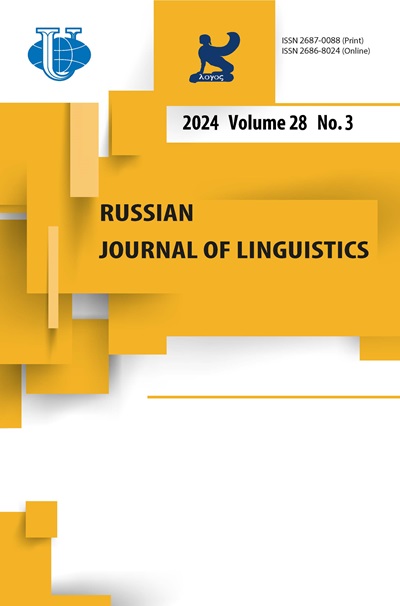Модели окказиональных метафор и их влияние на глазодвигательное поведение и распознавание в родном и иностранном языках
- Авторы: Киосе М.И.1,2
-
Учреждения:
- Московский государственный лингвистический университет
- Институт языкознания РАН
- Выпуск: Том 27, № 2 (2023)
- Страницы: 297-315
- Раздел: Статьи
- URL: https://journals.rudn.ru/linguistics/article/view/35191
- DOI: https://doi.org/10.22363/2687-0088-30055
- EDN: https://elibrary.ru/LNFJCF
Цитировать
Полный текст
Аннотация
В исследовании решается проблема установления различий в восприятии и распознавании окказиональных метафор в тексте на родном и иностранном языках, обусловленных как особенностями ассоциативного мышления читателей, так и характеристиками самих метафор. Целью настоящей работы является определение влияния ряда базовых метафорических моделей на глазодвигательное поведение и распознавание текстовых окказиональных метафор в родном (русском) и иностранном (английском) языках. В качестве материала исследования используются фрагменты художественных текстов, содержащие окказиональные метафоры в разных синтаксических позициях; также материалом выступают характеристики глазодвигательного поведения читателей и ответы читателей, фиксирующие распознавание сфер-целей метафоры. Методологически исследование опирается на постулат о значимости когнитивного процесса установления аналогий (analogical reasoning) и его основной характеристики, скорости ассоциативного мышления, для чтения и распознавания метафор на родном и иностранном языках, а также на постулат о влиянии типов базовых метафорических моделей (СТАТИЧЕСКИЙ ОБЪЕКТ ЕСТЬ ДИНАМИЧЕСКИЙ ОБЪЕКТ, ЧАСТИ ЕСТЬ ЦЕЛОЕ, АБСТРАКТНОЕ ЕСТЬ КОНКРЕТНОЕ) на восприятие и понимание содержания прочитанного. Гипотеза исследования заключается в том, что восприятие и распознавание метафор будет демонстрировать определенные различия применительно к родному и иностранному языку, что обусловлено скоростью установления ассоциаций. Результаты проведенного окулографического эксперимента показали отсутствие различий в успешности распознавания модели СТАТИЧЕСКИЙ ОБЪЕКТ ЕСТЬ ДИНАМИЧЕСКИЙ ОБЪЕКТ, в то время как успешность распознавания моделей ЧАСТИ ЕСТЬ ЦЕЛОЕ, АБСТРАКТНОЕ ЕСТЬ КОНКРЕТНОЕ выше в родном языке. Также установлено, что модель СТАТИЧЕСКИЙ ОБЪЕКТ ЕСТЬ ДИНАМИЧЕСКИЙ ОБЪЕКТ стимулирует увеличение продолжительности глазодвигательных реакций. Полученные результаты свидетельствуют о ранжированной значимости базовых метафорических моделей для восприятия и понимания, что позволяет уточнить их роль в процессах конструирования информации на родном и иностранном языках.
Об авторах
Мария Ивановна Киосе
Московский государственный лингвистический университет; Институт языкознания РАН
Автор, ответственный за переписку.
Email: maria_kiose@mail.ru
ORCID iD: 0000-0001-7215-0604
доктор филологических наук, доцент, ведущий научный сотрудник Центра социокогнитивных исследований дискурса Московского государственного лингвистического университета и Лаборатории мультиканальной коммуникации Института языкознания РАН. В сферу ее научных интересов входят: когнитивная семантика, непрямое наименование в тексте, референциальная семантика, окулографические и корпусные методы анализа восприятия и порождения текста.
Москва, РоссияСписок литературы
- Altmann, Gerry T. M., Alan Garnham & Yvette Dennis. 1992. Avoiding the garden path: Eye movements in context. Journal of Memory and Language 31. 685-712.
- Ashby, Jane, Carlos Roncero, Roberto de Almeida & Stephen Agauas. 2017. The early processing of metaphors and similes: Evidence from eye movements. Quarterly Journal of Experimental Psychology (Hove) 1. 1-9. https://doi.org/10.1080/17470218.2016.1278456
- Boers, Frank & Seth Lindstroember. 2012. Experimental and intervention studies on formulaic sequences in a second language. Annual Review of Applied Linguistics 32. 83-110. https://doi.org/10.1017/S0267190512000050
- Carroll, John B. 1993. Human Cognitive Abilities: A Survey of Factor-analytic Studies. New York, NY: Cambridge University Press.
- Chen, Siyuan. 2014. Cognitive load measurement from eye activity: Acquisition, efficacy, and real-time system design. PhD Thesis. Sydney: The University of New South Wales.
- Chen, Siyuan & Julien Epps. 2019. Task Load Estimation from Multimodal Head-Worn Sensors using Event Sequence Features. IEEE Transactions on Affective Computing 1. 1-14. https://doi.org/10.1109/EMBC.2015.7319555
- Divjak, Dagmar, Petar Milin & Srdan Medimorec. 2020. Construal in language: A visual-world approach to the effects of linguistic alternations on event perception and conception. Cognitive Linguistics 19. 37-72. https://doi.org/10.1515/cog-2018-0103
- Fauconnier, Gilles. 2001. Conceptual blending and analogy. In Dedre Gentner, Keith J. Holyoak & Boicho N. Kokinov (eds.), The Analogical mind: Perspectives from cognitive science, 254-285. Cambridge, Mass.: MIT Press.
- Flecken, Monique, Johannes Gerwien, Mary Carroll & Christiane von Stutterheim. 2015. Analyzing gaze allocation during language planning; A cross-linguistic study on dynamic events. Language and Cognition 7. 138-166.
- Gentner, Dedre. 1983. Structure-Mapping: A theoretical framework for analogy. Cognitive Science 7 (2). 155-170. Amsterdam: Elsevier Science B.V.
- Gentner, Dedre & Brian Bowdle. 2008. Metaphor as structure-mapping. The Cambridge Handbook of Metaphor and Thought. 109-128. Cambridge: Cambridge University Press.
- Grady, Joseph E. 2007. Metaphor. In Dirk Geeraerts & Hubert Cuyckens (eds.), The Oxford handbook of cognitive linguistics, 188-213. Oxford: Oxford University Press.
- Guilford, Joy Paul. 1967. Creativity: Yesterday, today and tomorrow. The Journal of Creative Behavior 1 (1). 3-14.
- Holmqvist, Kenneth, Marcus Nyström, Richard Andersson, Richard Dewhurst, Halszka Jarodzka & Joost van de J. Veijer (eds.). 2011. Eye Tracking. A Comprehensive Guide to Methods and Measures. New York: Oxford University Press.
- Holyoak, Keith J. 1984. Analogical thinking and human intelligence. In Robert J. Sternberg (ed.), Advances in the psychology of human intelligence. Vol. 2. 199-230. Hillsdale, N.J.: Erlbaum.
- Holyoak, Keith J. & Dushan Stamenkovich. 2018. Metaphor comprehension: A critical review of theories and evidence. Psychological Bulletin 144. 641-671. https://doi.org/10.1037/bul0000145
- Iriskhanova, Olga. 2014. The Games of Focus in Language: Semantics, Syntax and Pragmatics of Focusing. Moscow: Yazyki slavianskoi kultury. (In Russ.).
- Kaushanskaya, Margarita & Katrina Rechtzigel. 2012. Concreteness effects in bilingual and monolingual wordlearning. Psychonomic Bulletin & Review 19. 935-941. https://doi.org/10.3758/s13423-012-0271-5
- Kiose, Maria I. 2020. The interplay of syntactic and lexical salience and its effect on default figurative responses. Studies in Logic, Grammar and Rhetoric 61 (74). 161-178. https://doi.org/10.2478/slgr-2020-0004
- Lakoff, George & Mark Turner. 1989. More than Cool Reason: A Field Guide to Poetic Metaphor. Chicago: University of Chicago Press.
- Langacker, Ronald W. 2016. Entrenchment in cognitive grammar. In Hans-Jorg Schmid (ed.), Entrenchment and the psychology of language learning. How we reorganize and adapt linguistic knowledge, 39-56. Washington DC: Mouton de Gruyter. https://doi.org/10.1037/15969-003
- Laposhina, Antonina N., Maria Yu. Lebedeva & Alexandra A. Berlin Khenis. 2022. Word frequency and text complexity: An eye-tracking study of young Russian readers. Russian Journal of Linguistics 26 (2). 493-514. https://doi.org/10.22363/2687-0088-30084
- Littlemore, Jeannette, Phyllis T. Chen, Almut Koester & John Barnden. 2011. Difficulties in metaphors comprehension faced by international students whose first language is not English. Applied Linguistics 32. 408-429. https://doi.org/10.1093/applin/amr009
- Noë, Alva & J. Kevin O’Regan. 2001. A sensorimotor account of vision and visual consciousness. Behavioral and Brain Sciences 24 (5). 883-917.
- Papafragou, Anna, Justin Hulbert & John Trueswell. 2008. Does language guide event perception? Evidence from eye movements. Cognition 108. 155-184. https://doi.org/155-184. 10.1016/j.cognition.2008.02.007
- Pollio, Howard & Michael Smith. 1980. Metaphoric Competence and Complex Human Problem Solving. Cognition and Figurative Language. 365-392. Hillsdale, NJ: Erlbaum.
- Rayner, Keith. 1998. Eye movements in reading and information processing: 20 years of research. Psychological Bulletin 124 (3). 372-422.
- Siewerska, Anna. 2004. On the discourse basis of person agreement. In Tuija Verhagen (ed.), Approaches to cognition through text and discourse, 33-48. Berlin, New York: Mouton de Gruyter.
- Siyanova-Chanturia, Anna, Kathy Conklin & Norbert Schmitt. 2011. Adding more fuel to the fire: An eye tracking study of idiom processing by native and non-native speakers. Second Language Research 27. 251-272. https://doi.org/10.1177/0267658310382068
- Schmid, Hans-Jorg (ed.). 2016. Entrenchment and the Psychology of Language Learning. How We Reorganize and Adapt Linguistic Knowledge. Washington DC: Mouton de Gruyter. https://doi.org/10.1515/9783110341423
- Solovyev, Valery D., Yulia A. Volskaya, Mariia I. Andreeva & Artem A. Zaikin. 2022a. Russian dictionary with concreteness / abstractness indices. Russian Journal of Linguistics 26 (2). 515-549. https://doi.org/10.22363/2687-0088-29475
- Solovyev, Valery D., Marina. I. Solnyshkina, & Danielle S. McNamara. 2022b. Computational linguistics and discourse complexology: Paradigms and research methods. Russian Journal of Linguistics 26 (2). 275-316. https://doi.org/10.22363/2687-0088-31326
- Staub, Adrian. 2015. Reading sentences: Syntactic parsing and semantic interpretation. In Alexander Pollatsek & Rebecca Treiman (eds.), The Oxford handbook of reading, 202-216. Oxford: Oxford University Press.
- Steen, Gerard J., Aletta G. Dorst, J. Berenike Herrmann, Anna A. Kaal, Tina Krennmayr & Tryntie Pasma. 2010. A Method for Linguistic Metaphor Identification: From MIP to MIPVU. Amsterdam: John Benjamins Publishing Company. https://doi.org/10.1075/celcr.14
- Toldova, Svetlana, Natalia Slioussar & Anastasia Bonch-Osmolovskaya. 2022. Discourse complexity in the light of eye-tracking: A pilot Russian language study. Russian Journal of Linguistics 26 (2). 449-470. https://doi.org/10.22363/2687-0088-30140
- DRL - Slovar’ russkogo yazyka. 1999. [The Dictionary of the Russian Language] Anna P. Evgenjeva (ed.). Moscow: Rus. yaz.; Poligraphresursy. (in Russ.). (accessed 28 January 2022)
- Heredia, Roberto R. & Elva A. García. 2017. Bilingual Episodic Memory Processes. In: Alfredo Ardila, Anna B. Cieślicka, Roberto R. Heredia & Mónica Rosselli, Psychology of Bilingualism. The Cognitive and Emotional World of Bilinguals. Berlin: Springer. https://www.researchgate.net/publication/321494806_Bilingual_Episodic_Memory_Processes. https://doi.org/10.1007/978-3-319-64099-0_6 (accessed 28 January 2022)
- Littlemore, Jeannette. 2002. Developing Metaphor Interpretation Strategies for Students of Economics: A Case Study. Recherche et pratiques pédagogiques en langues de spécialité. http://journals.openedition.org/apliut/4119 (accessed 22 December 2021)
- RNC - Russian National Corpus. (In Russ.). http://www.ruscorpora.ru/ (accessed 22 December 2021)
- COCA - Corpus of Contemporary American English. https://www.english-corpora.org/coca (accessed 20 January 2022)

















